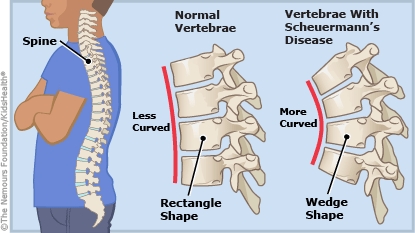Scheuermann's Kyphosis
Article Translations: (Spanish)
What Is Scheuermann's Kyphosis?
Scheuermann's kyphosis (kye-FOH-sis) is a condition affecting the upper back. It makes the upper back rounded so it looks hunched over. It's sometimes called Scheuermann's disease.
What Are the Signs & Symptoms of Scheuermann's Kyphosis?
The main signs of Scheuermann's kyphosis are:
- A rounded, hunched back. Sometimes the rounding is hard to see. Other times it can be more noticeable. Kids can't straighten their curve by standing up.
- Back pain. About half of kids with Scheuermann's kyphosis have back pain.
The signs of kyphosis often become obvious during the growth spurt that happens around puberty.
What Causes Scheuermann's Kyphosis?
The small bones (called vertebrae) that make up the spine are usually rectangular. They stack like bricks with flexible cartilage in between. When a child has Scheuermann's, the front edge of some of the vertebrae in the upper back grow slower than the back edge. These vertebrae become wedge shaped, so when the vertebrae stack up, the spine curves, making the back round out.

Doctors don't know exactly why some kids get it, but Scheuermann's kyphosis runs in families. The signs usually are first seen during or after the puberty growth spurt. Most kids are between 12 and 15 years old when they're diagnosed.
How Is Scheuermann's Kyphosis Diagnosed?
To diagnose Scheuermann's kyphosis, a doctor will:
- examine the spine: the child will stand, bend from the waist, and lie down
- get X-rays: to measure and assess the curve
How Is Scheuermann's Kyphosis Treated?
Kids with Scheuermann's kyphosis will see an orthopedist (a doctor who treats conditions involving the bones). The orthopedist will examine the spine, look at the X-rays, and recommend treatment.
Treatment options include:
Observation. If the rounding of the back isn't likely to cause any problems, kyphosis may not need any treatment. Kids will have routine checkups to make sure the rounding doesn't start causing problems. Most cases will stop progressing when kids are done growing.
Back brace. Your provider may recommend a brace. It's like a jacket that can be worn under clothes. It may not straighten the curve, but will keep it from getting worse.
Physical therapy. Exercises that strengthen the muscles in the back and core to support the spine better can sometimes help.
Surgery. Surgery isn't usually needed. But doctors might recommend a procedure called a spinal fusion for a severe case that causes pain or breathing trouble.
What Else Should I Know?
It's important for teens with Scheuermann's kyphosis to get the right treatment before their growth is finished. The spine usually won't continue to curve after they're done growing. If your child complains of back pain or has a rounded upper back, talk to your doctor.
Note: All information is for educational purposes only. For specific medical advice, diagnoses, and treatment, consult your doctor.
© 1995-2024 KidsHealth ® All rights reserved. Images provided by iStock, Getty Images, Corbis, Veer, Science Photo Library, Science Source Images, Shutterstock, and Clipart.com

